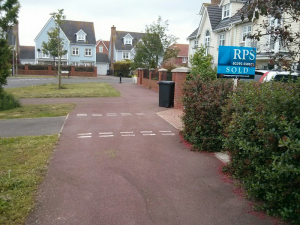Argh! Why is there a cyclist on the road when there’s a perfectly fine cycle track right next to them?
I used to get annoyed at the cyclists: perhaps too lazy or ignorant to switch across to the track. Now I realise I was wrong. It’s the tracks themselves which ought to attract the blame.
There are a few roundabouts near our home. The council has invested goodness-knows many thousands of pounds installing traffic lights at almost every junction. They are bike-activated. The cyclist must negotiate each set of lights in turn, cross to the wrong side of the road, use a prepared track and cross back over several hundred yards later.
It’s quicker to cycle on the road. Despite all the efforts of the council, cyclists do just that: they keep to the road. Mission failed.
As a cyclist I couldn’t bear to break the rules at first. I’d stop, wait and follow the lines all the way through. It took a long time but I felt good for being good. Over time though, my patience slipped and I’d follow the quicker route on the road. I felt a little dirty, irresponsible and guilty, but by goodness it was nice to be able to get somewhere without faffing about.
Nowadays the British highway engineers are increasingly looking across the North Sea to our Dutch neighbours for inspiration. Cycling is a national passion over there, right up with pancakes and windmills.
Having now had the pleasure of nearly a decade in the Netherlands, both as a regular cyclist and a car driver, I can attest to the sheer brilliance of the Dutch cycle network.
It creates an equal footing between the driver and the cyclist: drivers yield to cyclists to offer the latter some continuity; cyclists face penalties for breaking the rules. Both are expected to offer and receive respect in equal doses.
Above all else, the Dutch cycle network offers continuity. The cycle paths, be they dedicated, shared or by road, are uninterrupted. Bar few exceptions, traffic lights exist only where they also exist for motor users – you can pretty well cycle to most places without having to get off.
Similarly, the small matters count a great deal: cycle paths have priority over side road traffic. If a car turns into a side road they must yield to cycle traffic before completing their turn. Compare that to the UK where the convention is squarely in favour of the driver: cyclists on tracks must yield when crossing side-roads.

In fact, in a nearby estate, I noticed the shared footpath/cycle track had regular give way signs. The cyclists were being instructed to give way to cars from driveways. This is a completely counter-intuitive priority system and reinforces the driver’s perceived rule of the road.
It comes back to my first point, why would a cyclist willingly use a path where they must yield to every turning car when, by cycling on the road, they are afforded greater priority? The whole system is daft from the outset.
Of course, one could argue the Great British driver is unaccustomed to this. They’ll turn into a side road or driveway assuming priority. Bang goes the cyclist; accidents shoot through the roof. Fear often inhibits progress, and I’d suggest this is one such occasion. We need to be more confident about re-thinking our strategies around cycling.
While I accept the UK roads are often irregular, too narrow or too congested to offer widespread benefits to cyclists, I do hope that more can be made to make an integrated, continuous cycle path system. This autumn, I’m hoping to get my UK bike back in order. There are cycle paths all the way to the nearest two major towns but the priority system is a mess. It’s a genuine dissuasion to ride.
I hope that one day, riding a bike in the UK is as convenient to all road users as they’ve already shown to be in the Netherlands and that our many miles of investment in cycle infrastructure can be fully utilised, rather than ignored and bypassed in the ways that they seem to be currently.